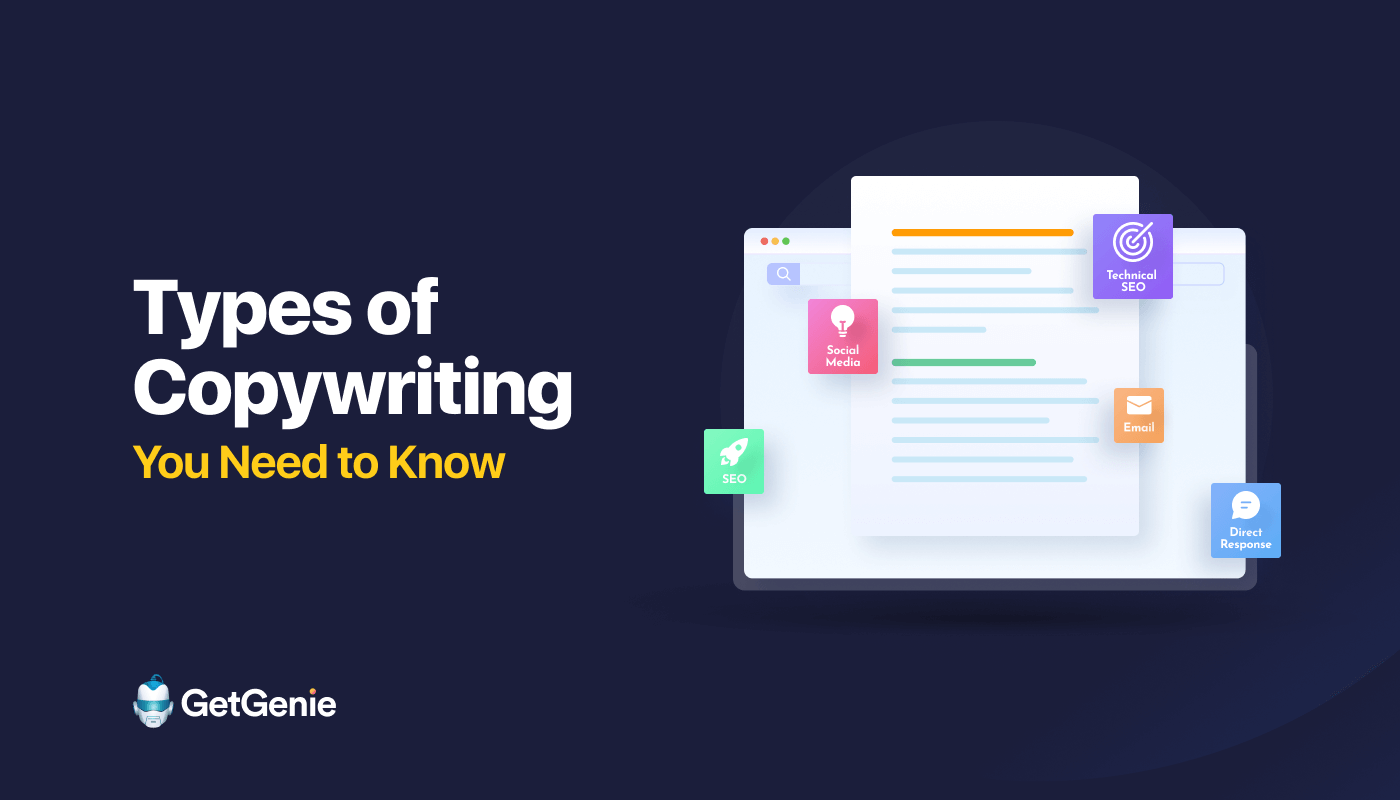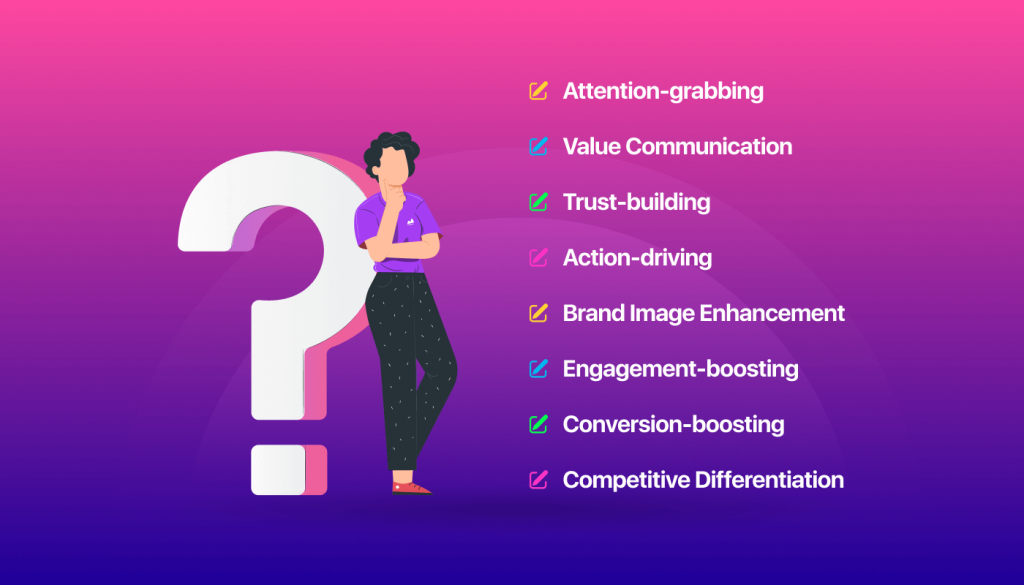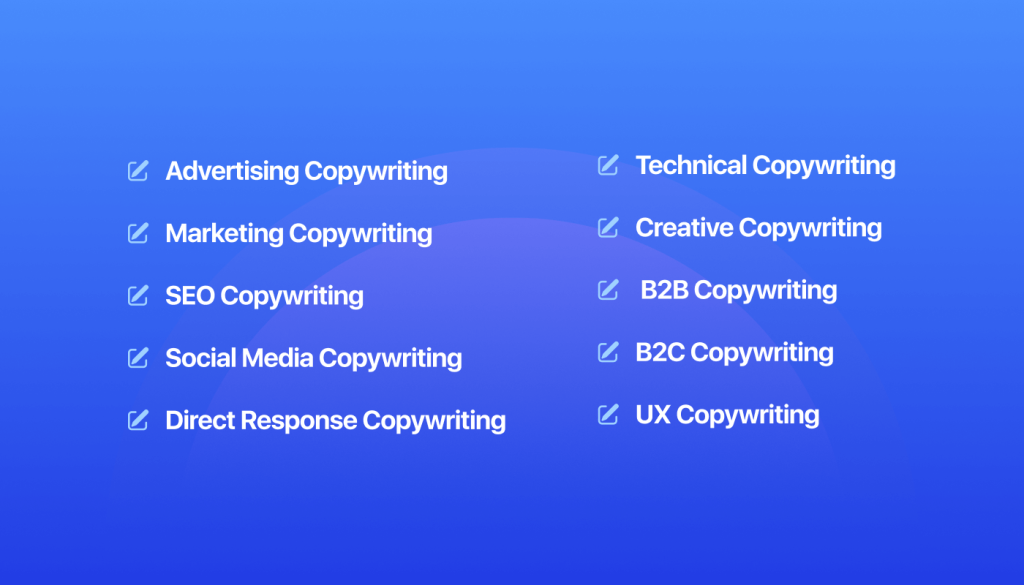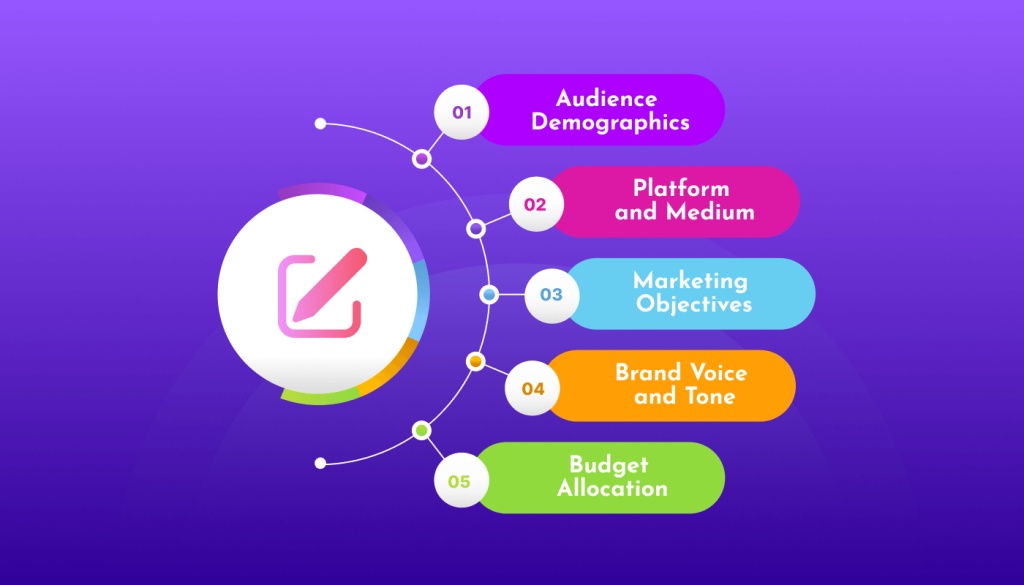10 Types of Copywriting You Need to Know

When walking through a bustling city street; among the chaos, one billboard stands out, its message sparking an immediate emotional response.
Again, you’re checking your email inbox flooded with promotional messages. One subject line catches your eye, teasing an irresistible offer that prompts you to open the email.
In both scenarios, it’s not just the visuals that capture your attention – it’s the power of copywriting.
However, not all copywriting types and styles are the same. They vary according to the mediums and targeted audiences.
In this blog post, we’re going to explore the 10 different types of copywriting to enhance your marketing strategy.
- What is Copywriting?
- Why is Copywriting Important?
- 7 Types of Copywriting Frameworks: At a Glance
- 10 Types of Copywriting with Examples: In-depth Overview
- 5 Considering Factors while Choosing Copywriting Type
- Bonus: Copywriting Fundamentals
- What are the 5 levels of copywriting?
- What are the 4 P's of copywriting?
- What are the 4 C's of copywriting?
- What are the types of tones in copywriting?
- What is the golden rule of copywriting?
- What are the differences between a content writer and a copywriter?
- What are the Advantages and Disadvantages of Copywriting?
- Wrap it up
What is Copywriting?
Copywriting is a process of crafting content to promote products, services, or ideas. The primary goals of copywriting are persuading, informing, or engaging a specific audience to take action such as clicking a button, signing up, purchase, etc.
Copywriting categories include advertisements, website content, product descriptions, social media posts, email campaigns, blog posts, and more. The fundamental guideline for copy length should be to make it as long as needed, but not a word more.
Why is Copywriting Important?

Effective copywriting can significantly impact conversion rates and overall business success. Here are the reasons why good copywriting is important:
- Grabbing attention effectively with copywriting
- Communicating the value of a product or service clearly
- Building trust through clear and authentic messaging
- Driving specific actions from the audience
- Enhancing brand image by shaping perception and values
- Boosting engagement with interactive content
- Increasing conversions through an optimized copy
- Differentiating from competitors by highlighting unique selling points and so on!
7 Types of Copywriting Frameworks: At a Glance
A copywriting framework is a structured approach or methodology used by copywriters to create persuasive and effective content. These frameworks provide a step-by-step process for copywriting for advertisements, marketing materials, websites, or other communication channels.
Let’s explore some most popular copywriting frameworks with their functionalities:
| Framework Name | Full Form | Functionality |
|---|---|---|
| AIDA | Attention, Interest, Desire, Action | Grabbing attention, generating interest, creating desire, and prompting action from the audience. |
| PAS | Problem, Agitation, Solution | Identifying the problem, agitating it to create urgency, and presenting the solution (product or service) as the resolution. |
| FAB | Features, Advantages, Benefits | Breaking down product or service information into its features, the advantages those features provide, and the benefits to the customer. |
| 4Ps | Proximity, Problem, Proposal, Proof | Emphasizing the proximity of the message to the audience, identifying the problem, presenting a proposal, and providing proof or credibility. |
| BAB | Before, After, Bridge | Presenting the current situation (before), the desired outcome (after), and how the product or service bridges the gap between the two. |
| STAR | Situation, Task, Action, Result | Useful for case studies or testimonials, outlining the situation, task, action taken, and the resulting outcome for effective storytelling. |
| PASTOR | Problem, Amplify, Solution, Transformation, Offer, Response | Addressing the reader’s problem, amplifying it, presenting the solution and transformation, making an offer, and eliciting a response. |
To learn more, you can check out – 7 Best Copywriting Frameworks for Better Conversions
10 Types of Copywriting with Examples: In-depth Overview

Copywriting is more than just strings of letters – they’re powerful tools that can influence, persuade, and inspire action. There are lots of variations and categories in copywriting.
Each type brings its own set of strategies, principles, and best practices for different platforms, objectives, and target audiences.
Here are 10 common forms of copywriting:
1. Advertising Copywriting
Advertising or promotional copywriting formats involve creating persuasive and attention-grabbing content specifically for advertisements across various media channels. This type of copywriting helps to capture the audience’s interest quickly and convince them to take action, such as making a purchase or visiting a website.
Suitable Framework(s): AIDA (Attention, Interest, Desire, Action), BAB (Before, After, Bridge), PAS (Problem, Agitation, Solution)
Examples:
- Print: Eye-catching headlines and persuasive body copy in magazine ads. People around 80% of people read the headline of a copy, rest 20% continue the rest.
- TV: Engaging scripts for television commercials that evoke emotion and showcase the product or service.
- Radio: Catchy jingles and concise messaging for radio advertisements.
- Digital: Compelling ad copy for online banners, Google Ads, and social media ads targeting specific demographics.
2. Marketing Copywriting
Marketing copywriting is writing content to promote products or services to potential customers. It encompasses a wide range of content marketing forms such as sales pages, product descriptions, content marketing articles, and email marketing campaigns.
Suitable Framework(s): AIDA, PAS, FAB (Features, Advantages, Benefits)
Examples:
- Sales pages: Persuasive landing pages that highlight the benefits of a product or service and encourage conversions.
- Product descriptions: Informative and engaging descriptions that showcase the features and benefits of a product.
- Content marketing: Educational articles or blog posts that provide value to the audience while subtly promoting products or services.
- Email marketing: Among digital marketing channels, email marketing boasts the highest ROI (Return on Investment). So, compelling email campaigns that use storytelling and persuasive language to drive conversions and engagement.
3. SEO Copywriting
Incorporating search engine principles copies, effective SEO copywriting helps to enhance visibility and rankings on search engine results pages (SERPs). This type of copywriting strategically integrates relevant keywords into content while ensuring readability and delivering value to the reader.
Suitable Framework(s): PASO (Problem, Amplify, Solve, Outcome), 4Ps (Promise, Picture, Proof, Push)
Examples:
- Website content: Informative and engaging website pages optimized with relevant keywords to improve search engine rankings.
- Blog posts: Promotional, WooCommerce product reviews, and featured-based blog posts that address promoting products and services while incorporating targeted keywords.
4. Direct Response Copywriting
Direct response copywriting focuses on creating compelling content to create an immediate response or action from the audience. The most common types of direct response copywriting are making a purchase, signing up for a newsletter, or filling out a form, through persuasive language and a clear call to action.
Suitable Framework(s): AIDA, PAS, 4Ps
Examples:
- Sales letters: Persuasive letters or emails that highlight the benefits of a product or service and include a strong call to action.
- Landing pages: Conversion-focused web pages designed to capture leads or drive sales with persuasive headlines, benefit-oriented content, and clear calls to action.
- Call-to-action: Direct and compelling phrases or buttons strategically placed throughout the copy to encourage immediate action from the reader.
5. Technical Copywriting
Technical copywriting involves creating clear and precise content to explain complex technical concepts or processes in a way that is easily understandable for the intended audience. It focuses on providing accurate information and instructions while maintaining clarity and readability.
Suitable Framework(s): PASO, 4Ps
Examples:
- User manuals: Detailed guides that explain how to use a product or service, including step-by-step instructions and troubleshooting tips.
- Instruction guides: Clear and concise documents that provide instructions for assembling or operating a product.
- Technical documentation: Comprehensive guides or documents that explain the technical specifications, features, and functionality of a product or service.
6. Social Media Copywriting
Social media copywriting is the way of crafting concise and captivating copy for diverse social media platforms such as Facebook, Twitter, LinkedIn, etc. This form of copywriting helps to captivate, engage, and interact with the target audience effectively. Also, video script is a part of social media copywriting.
According to Wyzowl’s report, video content contributes to generating leads and sales by 87% and boosting site traffic by 86%.
Overall, social media copywriting helps to develop messages to match with the platform’s user base, and prompt actions such as liking, commenting, or sharing.
Suitable Framework(s): AIDA, PAS, PASTOR(Problem, Amplify, Solution, Transformation, Offer, Response)
Examples:
- Facebook posts: Compelling posts that include visuals, captions, and calls to action (CTAs) to encourage engagement and interaction.
- Tweets: Concise and attention-grabbing tweets within 280 characters that use hashtags and visuals to increase visibility and engagement.
- Instagram captions: Captivating captions that complement visually appealing images or videos and encourage users to engage with the content.
7. Creative Copywriting
Adding imaginative and innovative language, creative copywriting aims to grab attention and evoke emotions within the audience. It emphasizes the creation of distinctive and memorable messages that set a brand or product apart from competitors, aiming to leave a lasting and impactful impression.
Suitable Framework(s): PAS, AIDA, IDCA (Interest, Desire, Conviction, Action)
Examples:
- Taglines: Short and catchy phrases that encapsulate the essence of a brand or product and leave a memorable impression.
- Slogans: Memorable and persuasive phrases are used in advertising campaigns to convey a brand’s message or values.
- Brand storytelling: Compelling narratives that connect with the audience on an emotional level and convey the brand’s personality, values, or mission.
8. B2B Copywriting
B2B (Business-to-Business) copywriting is the process of creating content specifically targeted at businesses and organizations rather than individual consumers. It focuses on addressing the unique needs, challenges, and priorities of businesses and positioning products or services as solutions to those needs.
Suitable Framework(s): AIDA, FAB, BAB
Examples:
- Whitepapers: In-depth reports or guides that provide valuable insights, research, and analysis on industry trends, challenges, or solutions.
- Case studies: Detailed success stories that showcase how a product or service helped a business achieve specific goals or overcome challenges.
- Email marketing: Targeted email campaigns can bring the needs and interests of businesses, such as promoting B2B services or solutions.
9. B2C Copywriting
B2C (Business-to-Consumer) copywriting is produced targeting individual consumers. It focuses on addressing the needs, desires, and preferences of consumers and positioning products or services as solutions to their problems or desires.
Suitable Framework(s): AIDA, PAS, FAB
Examples:
- Product descriptions: Engaging and persuasive descriptions that highlight the benefits and features of a product and appeal to the emotions and desires of consumers.
- Email marketing: Personalized email campaigns based on the interests and preferences of individual consumers, such as promoting new products, discounts, or special offers.
- Content marketing: Informative and entertaining content that provides value to consumers while subtly promoting products or services.
10. UX Copywriting
UX (User Experience) copywriting is a popular type of copywriting where copywriters create clear, precise, and concise content to enhance the usability and user experience of websites, apps, and digital products. It focuses on guiding users through the interface, providing helpful instructions and feedback, and encouraging engagement and interaction.
Suitable Framework(s): AIDA, PASO, 4Ps
Examples:
- Microcopy: Short and informative text snippets strategically placed throughout the interface to guide users, provide feedback, and encourage action (e.g. error messages, tooltips, button labels).
- Onboarding flows: Clear and concise instructions or prompts that guide users through the initial setup or onboarding process of a digital product or app.
- Form fields and labels: Descriptive and user-friendly labels for form fields that help users understand what information is required and why.
5 Considering Factors while Choosing Copywriting Type

Choosing the right type of copywriting is crucial for marketing and business success. Marketers must consider the following factors to resonate with the target audience and make an informed decision.
Audience Demographics
- Understand the preferences, characteristics, and behaviors of the target audience.
- Select a copywriting type to resonate with specific demographics.
- Consider factors such as age, gender, location, interests, and purchasing behavior.
Platform and Medium
- Choose a copywriting type based on where the content will be displayed.
- Consider the characteristics and requirements of different platforms (e.g. social media, website, print media).
- Adapt copywriting style to suit the medium’s format and constraints.
Marketing Objectives
- Align copywriting type with the overall objectives of the marketing campaign.
- Determine whether the goal is to drive sales, increase brand awareness, generate leads, or educate the audience.
- Select copywriting techniques that support and contribute to achieving these objectives.
Brand Voice and Tone
- Maintain consistency with the brand’s voice and tone across all copywriting efforts.
- Reflect on the brand’s personality, values, and communication style in the chosen type of copywriting.
- Ensure that the copywriting style resonates with the target audience and reinforces brand identity.
Budget Allocation
- Consider the budget allocated for the marketing campaign.
- Evaluate the resources and investment required for different kinds of copywriting.
- Choose copywriting techniques that align with budget constraints while still prioritizing effectiveness and impact.
Bonus: Copywriting Fundamentals
What are the 5 levels of copywriting?
The 5 levels of copywriting are sequential steps in the copy-creation process such as
- Prepare: Conduct research, gather information, and plan the copywriting project.
- Organize: Structure the gathered information logically to ensure coherence and flow in the copy.
- Write: Create the actual content, focusing on communicating the intended message effectively.
- Edit: Review and revise the content for clarity, grammar, style, and overall quality improvement.
- Review: Evaluate the finalized copy to ensure it meets the objectives and desired standards.
What are the 4 P’s of copywriting?
The 4 P’s of copywriting are foundational principles representing the following:
- Product: Describe the features and benefits of the product or service being promoted.
- Price: Communicate the pricing details and any associated discounts or offers.
- Place: Specify where the product or service is available, whether online, in stores, or through other channels.
- Promotion: Develop strategies to market and advertise the product or service effectively.
What are the 4 C’s of copywriting?
The 4 C’s of copywriting refer to key qualities that effective copy should embody such as
- Clear: Ensure the message is easily understood by the target audience.
- Concise: Communicate the message succinctly and avoid unnecessary verbosity.
- Compelling: Create content that captivates and persuades the audience to take action.
- Credible: Provide accurate information that builds trust and credibility with the audience.
What are the types of tones in copywriting?
Copywriting can employ various tones depending on the message and audience including
- Formal: Professional and serious tone suitable for business or technical content.
- Conversational: Friendly and approachable tone that fosters engagement with the audience.
- Persuasive: Convincing and compelling tone designed to motivate action or change opinions.
- Instructional: A clear and informative tone used to guide the audience through processes or procedures.
What is the golden rule of copywriting?
The golden rule of copywriting is to “know your audience”. Understanding the target audience’s preferences, needs, and behaviors enables the creation of more relevant and effective copy.
What are the differences between a content writer and a copywriter?
Content writers primarily produce informative and valuable content for education or entertainment, focusing on building awareness and engagement. Copywriters, on the other hand, specialize in persuasive writing aimed at prompting specific actions, such as making a purchase or filling out a form, to achieve business goals.
What are the Advantages and Disadvantages of Copywriting?
Copywriting effectively persuades and engages audiences, driving sales and brand loyalty, but it can be time-consuming and requires copywriting skills to avoid being perceived as manipulative or insincere.
Wrap it up
Copywriting is the art of creating persuasive written content that convinces people to take action. It’s about crafting compelling messages that not only grab attention but also drive results in sales and revenues.
We’ve discussed the fundamentals of copywriting. Also, 10 common types of copywriting along with the frameworks and use cases. You can utilize these copywriting styles to promote your brands and services using AI tools like GetGenie AI. Hope, now you can help businesses to connect with their audience, boost conversions, and achieve their goals.
Which one is your favorite copywriting style? Don’t forget to share with us!

